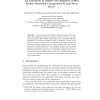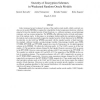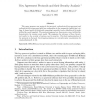ASIACRYPT
2006
Springer
14 years 7 months ago
2006
Springer
Currently, the best and only evidence of the security of the OAEP encryption scheme is a proof in the contentious random oracle model. Here we give further arguments in support of...
ASIACRYPT
2006
Springer
14 years 7 months ago
2006
Springer
Understanding what construction strategy has a chance to be a good hash function is extremely important nowadays. In TCC'04, Maurer et al. [13] introduced the notion of indiff...
ACISP
2006
Springer
14 years 8 months ago
2006
Springer
Abstract. A security proof in the Bellare
PKC
2010
Springer
14 years 8 months ago
2010
Springer
Liskov proposed several weakened versions of the random oracle model, called weakened random oracle models (WROMs), to capture the vulnerability of ideal compression functions, wh...
ACISP
2007
Springer
14 years 8 months ago
2007
Springer
Abstract. We propose new instantiations of chosen-ciphertext secure identitybased encryption schemes with wildcards (WIBE). Our schemes outperform all existing alternatives in term...
IMA
1997
Springer
14 years 8 months ago
1997
Springer
This paper proposes new protocols for two goals: authenticated key agreement and authenticated key agreement with key con rmation in the asymmetric
public-key
setting. A formalm...
EUROCRYPT
1998
Springer
14 years 8 months ago
1998
Springer
Abstract. Provable security is a very nice property for cryptographic protocols. Unfortunately, in many cases, this is at the cost of a considerable loss in terms of efficiency. Mo...
ASIACRYPT
2000
Springer
14 years 8 months ago
2000
Springer
Assuming a cryptographically strong cyclic group G of prime order q and a random hash function H, we show that ElGamal encryption with an added Schnorr signature is secure against ...
EUROCRYPT
2001
Springer
14 years 8 months ago
2001
Springer
Abstract. Known practical blind signature schemes whose security against adaptive and parallel attacks can be proven in the random oracle model either need five data exchanges bet...
CTRSA
2001
Springer
14 years 8 months ago
2001
Springer
The Pintsov-Vanstone signature scheme with partial message recovery (PVSSR) is a variant of the Schnorr and Nyberg-Rueppel signature schemes. It produces very short signatures on ...



